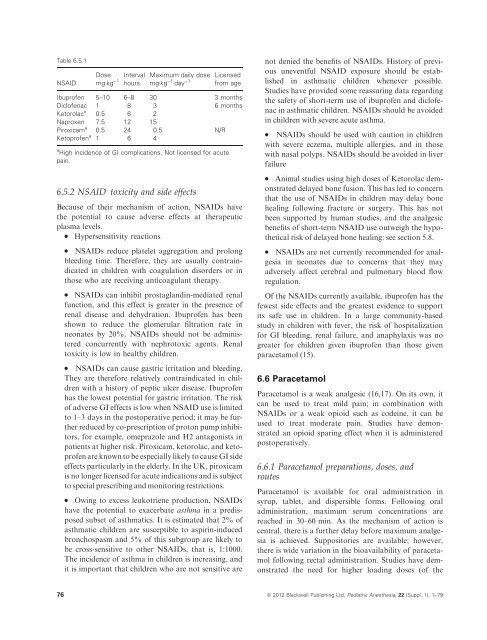Good Practice in Postoperative and Procedural Pain Management ...
Good Practice in Postoperative and Procedural Pain Management ...
Good Practice in Postoperative and Procedural Pain Management ...
You also want an ePaper? Increase the reach of your titles
YUMPU automatically turns print PDFs into web optimized ePapers that Google loves.
Table 6.5.1NSAIDDosemgÆkg )1IntervalhoursMaximum daily dosemgÆkg )1 Æday )1Licensedfrom ageIbuprofen 5–10 6–8 30 3 monthsDiclofenac 1 8 3 6 monthsKetorolac a 0.5 6 2Naproxen 7.5 12 15Piroxicam a 0.5 24 0.5 N/RKetoprofen a 1 6 4a High <strong>in</strong>cidence of GI complications. Not licensed for acutepa<strong>in</strong>.6.5.2 NSAID toxicity <strong>and</strong> side effectsBecause of their mechanism of action, NSAIDs havethe potential to cause adverse effects at therapeuticplasma levels.l Hypersensitivity reactionsl NSAIDs reduce platelet aggregation <strong>and</strong> prolongbleed<strong>in</strong>g time. Therefore, they are usually contra<strong>in</strong>dicated<strong>in</strong> children with coagulation disorders or <strong>in</strong>those who are receiv<strong>in</strong>g anticoagulant therapy.l NSAIDs can <strong>in</strong>hibit prostagl<strong>and</strong><strong>in</strong>-mediated renalfunction, <strong>and</strong> this effect is greater <strong>in</strong> the presence ofrenal disease <strong>and</strong> dehydration. Ibuprofen has beenshown to reduce the glomerular filtration rate <strong>in</strong>neonates by 20%. NSAIDs should not be adm<strong>in</strong>isteredconcurrently with nephrotoxic agents. Renaltoxicity is low <strong>in</strong> healthy children.l NSAIDs can cause gastric irritation <strong>and</strong> bleed<strong>in</strong>g.They are therefore relatively contra<strong>in</strong>dicated <strong>in</strong> childrenwith a history of peptic ulcer disease. Ibuprofenhas the lowest potential for gastric irritation. The riskof adverse GI effects is low when NSAID use is limitedto 1–3 days <strong>in</strong> the postoperative period; it may be furtherreduced by co-prescription of proton pump <strong>in</strong>hibitors,for example, omeprazole <strong>and</strong> H2 antagonists <strong>in</strong>patients at higher risk. Piroxicam, ketorolac, <strong>and</strong> ketoprofenare known to be especially likely to cause GI sideeffects particularly <strong>in</strong> the elderly. In the UK, piroxicamis no longer licensed for acute <strong>in</strong>dications <strong>and</strong> is subjectto special prescrib<strong>in</strong>g <strong>and</strong> monitor<strong>in</strong>g restrictions.l Ow<strong>in</strong>g to excess leukotriene production, NSAIDshave the potential to exacerbate asthma <strong>in</strong> a predisposedsubset of asthmatics. It is estimated that 2% ofasthmatic children are susceptible to aspir<strong>in</strong>-<strong>in</strong>ducedbronchospasm <strong>and</strong> 5% of this subgroup are likely tobe cross-sensitive to other NSAIDs, that is, 1:1000.The <strong>in</strong>cidence of asthma <strong>in</strong> children is <strong>in</strong>creas<strong>in</strong>g, <strong>and</strong>it is important that children who are not sensitive arenot denied the benefits of NSAIDs. History of previousuneventful NSAID exposure should be established<strong>in</strong> asthmatic children whenever possible.Studies have provided some reassur<strong>in</strong>g data regard<strong>in</strong>gthe safety of short-term use of ibuprofen <strong>and</strong> diclofenac<strong>in</strong> asthmatic children. NSAIDs should be avoided<strong>in</strong> children with severe acute asthma.l NSAIDs should be used with caution <strong>in</strong> childrenwith severe eczema, multiple allergies, <strong>and</strong> <strong>in</strong> thosewith nasal polyps. NSAIDs should be avoided <strong>in</strong> liverfailurel Animal studies us<strong>in</strong>g high doses of Ketorolac demonstrateddelayed bone fusion. This has led to concernthat the use of NSAIDs <strong>in</strong> children may delay boneheal<strong>in</strong>g follow<strong>in</strong>g fracture or surgery. This has notbeen supported by human studies, <strong>and</strong> the analgesicbenefits of short-term NSAID use outweigh the hypotheticalrisk of delayed bone heal<strong>in</strong>g: see section 5.8.l NSAIDs are not currently recommended for analgesia<strong>in</strong> neonates due to concerns that they mayadversely affect cerebral <strong>and</strong> pulmonary blood flowregulation.Of the NSAIDs currently available, ibuprofen has thefewest side effects <strong>and</strong> the greatest evidence to supportits safe use <strong>in</strong> children. In a large community-basedstudy <strong>in</strong> children with fever, the risk of hospitalizationfor GI bleed<strong>in</strong>g, renal failure, <strong>and</strong> anaphylaxis was nogreater for children given ibuprofen than those givenparacetamol (15).6.6 ParacetamolParacetamol is a weak analgesic (16,17). On its own, itcan be used to treat mild pa<strong>in</strong>; <strong>in</strong> comb<strong>in</strong>ation withNSAIDs or a weak opioid such as code<strong>in</strong>e, it can beused to treat moderate pa<strong>in</strong>. Studies have demonstratedan opioid spar<strong>in</strong>g effect when it is adm<strong>in</strong>isteredpostoperatively.6.6.1 Paracetamol preparations, doses, <strong>and</strong>routesParacetamol is available for oral adm<strong>in</strong>istration <strong>in</strong>syrup, tablet, <strong>and</strong> dispersible forms. Follow<strong>in</strong>g oraladm<strong>in</strong>istration, maximum serum concentrations arereached <strong>in</strong> 30–60 m<strong>in</strong>. As the mechanism of action iscentral, there is a further delay before maximum analgesiais achieved. Suppositories are available; however,there is wide variation <strong>in</strong> the bioavailability of paracetamolfollow<strong>in</strong>g rectal adm<strong>in</strong>istration. Studies have demonstratedthe need for higher load<strong>in</strong>g doses (of the76 ª 2012 Blackwell Publish<strong>in</strong>g Ltd, Pediatric Anesthesia, 22 (Suppl. 1), 1–79
















